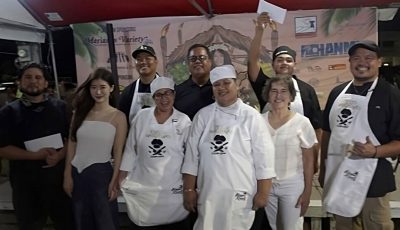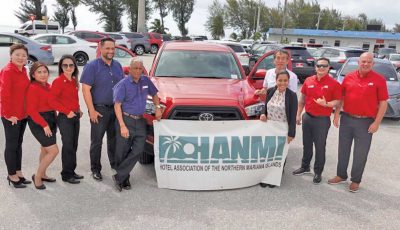HANMI scrambles for options

Hotel Association of the NMI chair Ivan Quichocho speaks to the media after yesterday’s monthly general membership meeting of HANMI at the Pacific Islands Club Saipan. Although the media was not allowed inside the meeting, Quichocho was able to recap and share with the media some highlights of the meeting shortly after. (CHRYSTAL MARINO)
The CNMI’s tourism numbers are slowly picking up, which is a good sign for the CNMI’s wobbly tourism sector, but the industry is also facing some pretty serious challenges down the line this year, according to Hotel Association of the NMI chair Ivan Quichocho.
Speaking to the media after yesterday’s monthly general membership meeting of HANMI at the Pacific Islands Club Saipan, Quichocho said the meeting was productive as they discussed the major challenges HANMI is facing, especially with so many foreign workers leaving starting in September due to the touchback rule—an immigration requirement for foreign workers.
“We’re on skeletons crews. A lot of the properties have moved down to skeletons crews,” he said.
Some of the options they are considering are the tourist professionals at the Latte Training Academy, Northern Marianas Technical Institute, and the Northern Marianas College, as they continue to churn out professionals who may want to get into the tourism industry.
Quichocho said that HANMI is also hoping that the CNMI delegation that is in Washington, D.C. right now—composed of representatives of HANMI, the Saipan Chamber of Commerce, and Commonwealth Ports Authority—for a “door knocking” campaign will result in some positive news.
“We’re extremely hopeful that they’re successful in delivering that message. I think they were, but we’re hopeful that something can come of it, like maybe a delay or extension [in the touchback rule]…” he said, adding that HANMI also submitted letters to the office of Delegate Gregorio Kilili C. Sablan (D-MP) and Gov. Arnold I. Palacios to support pushing back the touchback requirement.
When asked about HANMI’s stance on the touchback requirement, he said, “Quite frankly we don’t want to see a touchback.”
He noted that the CNMI has just opened its tourism “…so as we are starting to pick up steam, we continue to face challenges on our horizon and rough seas. …We’re fielding losses, and then you add on the expenses, you add a shortfall of key staff. …So all of these stacked up one on top the other, it can be pretty devastating to the industry.”
It is good that tourist numbers are climbing, but Quichocho said they are also dealing with a loss of manpower.
Add to that the CPA’s efforts to secure funding from the Federal Aviation Administration for the airport to continue to operate Essential Air Services. “One thing that you’re not hearing too much of is that if the airport doesn’t secure funding, the fees come September is going to be crazy expensive. That is going to get passed to the airline, which is going to do one of two things—either pass it to the customer or decide whether they can afford it or whether the consumer can carry that kind of a cost for this destination. So it really calls to question the viability of the route.”
When considering the concerns of HANMI as they move forward, he said they are dealing with the issue of construction and access to construction, the need to improve a product—in this case Saipan as a destination spot—the need for renovations and general facelift
“Number 1 is the cost. No. 2 is access. No. 3 is our manpower…then you have looming potential for increased cost through taxation, and then access to tourists—if CPA is going to be able to get the funding support from FAA or not. What is that going to mean for the airlines? What does it mean for ticket prices or operating costs for the airline to come to Saipan? So just those items alone are pretty heavy…”
Despite the swarm of challenges facing the industry, Quichocho believes that “there are a lot of smart people on this island that, if we can get together and kind of divvy up the target approach, all of this stuff can be overcome. It can be. Just got to get focused.”
On the bright side, he shared that Korean air service is picking up, with 29,000 air seats in July. Part of them were diverted flights that came to Saipan instead of Guam because of Typhoon Mawar.
But he believes that, in terms of air seats, the Korean market will be at 80 to 90% of pre-pandemic numbers by the end of the year.
“…We’re thinking it’s going to be around 80% to 90%t of what the seats were pre-pandemic by the end of the year. So the final quarter—October, November, and December—we anticipate that the air seats should be around 30,000 seats a month, a thousand seats a day, roughly for the Korean market. Japan will continue to be three times a week moving through another year, and… if you look at the stats, it’s starting to pick up some steam. The MVA’s been working very hard to fill those flights.” In June, flights were performing at 74%, he said, July was at 72%, and August bookings are looking good.
Although the media was not allowed inside the meeting, Quichocho was able to recap and share with reporters some highlights of the meeting shortly after.



























